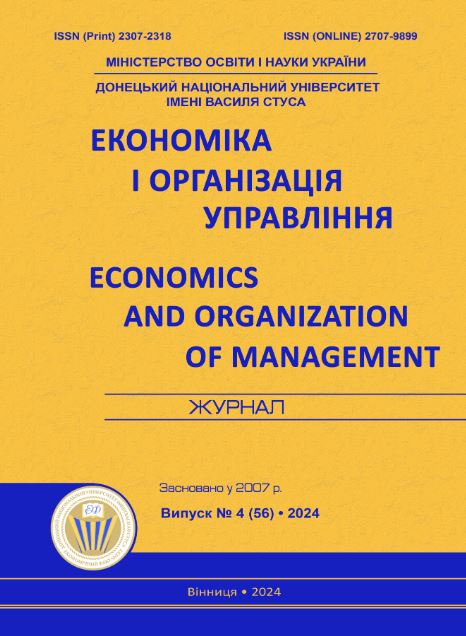Features of crisis management in developed countries
DOI:
https://doi.org/10.31558/2307-2318.2024.4.4Keywords:
crisis management, developed countries, crisis, EU countries, USAAbstract
The experience of developed countries in conducting anti-crisis policy measures is analyzed. The author found, that the priority of crisis management in most developed countries is the financial sector, the salvation of which can be manifested in exchange rate stabilization, reserve requirements as a financial policy tool, regulation of banking, insurance and securities markets, etc. Іn the Scandinavian countries, the main tools of crisis management usually are indirect methods of regulation through monetary policy measures. The priority of anti-crisis policy in the Scandinavian countries is education, health care, pensions, labor market, etc. Germany and Switzerland conduct special trainings to test resilience and ability to react to crisis. Experts are participants from all economic sectors and politics who estimate the governments’ ability to respond to crises. “The quantitative easing policy” in the USA, which aimed to purchase by central banks additional financial assets to “infuse” funds into the national economy is analyzed by author. “Quantitative easing” is perhaps the only monetary policy instrument that has helped advanced economies such as the United States, Japan, and the EU partially overcome the liquidity trap following the 2008 financial crisis.
In general, most developed countries use monetary policy tools as anti-crisis measures in order to accumulate funds for the stabilization fund. Central banks in industrialized countries use securities transactions in the open market to replenish the stabilization funds. In addition, the priority measures are to provide financial support and to increase product demand of those enterprises that have suffered the most during the crisis.
References
Пристайко В. В. Поняття та принципи антикризового управління: загальна характеристика. Вчені записки ТНУ імені В. І. Вернадського. Серія: Державне управління. 2017. Том 28 (67). № 2. C. 16-19.
Ложачевська О. М. Теоретичні та практичні аспекти антикризового менеджменту. Ефективна економіка. 2013. № 12. URL: http://www.economy.nayka.com.ua/?op=1&z=2572.
Савченко М., Шкуренко О. Формування механізму антикризового управління суб’єктами міжнародного бізнесу. Економічний аналіз. 2020. Том 30. № 4. С. 74-83.
Мельник В., Колесник О. Теоретичні аспекти дослідження сутності антикризового менеджменту банківських установ. Проблеми і перспективи економіки та управління. 2019. № 4 (20). C. 334-341.
Василенко В. О. Антикризове правління підприємством : навч. посіб. для студ. вищ. навч. закл. Центр навч. л-ри, 2015. 208 c. URL: http://eclib.atwebpages.com.
Плєшакова Н. А. Світовий досвід антикризового регулювання в зарубіжних країнах. Ефективна економіка. 2015. № 9. URL: http://www.economy.nayka.com.ua/pdf/9_2015/63.pdf.
Simola S. Teaching corporate crisis management through business ethics education // European Journal of Training and Development. 2014. 38(5):485-503. DOI: 10.1108/EJTD-05-2013-0055.
Coombs W. T. Crisis management and communications. 2014. URL: http://www.instituteforpr.org/crisis-management-communications.
Canyon D. Definitions in crisis management and crisis leadership. 2020. URL: https://apcss.org/wp-content/uploads/2020/01/Definitions-in-crisis-management-and-crisis-leadership-01242020.pdf.
Benaben F. A formal framework for crisis management describing information flows and functional structure. Procedia Engineering. 2016. № 159. С. 353–356.
Дідович І. І., Полякова Ю. В., Атаманчук З. А., Макогін З. Я. Застосування інструментів ризик-менеджменту при організації експорту органічної продукції до Європейського Союзу. Економіка і організація управління. 2023. № 2(50). С. 96-105. DOI: https://doi.org/10.31558/2307-2318.2023.2.9.
Guideline for Strategic Crisis Management Exercises. Federal Office of Civil Protection and Disaster Assistance (BBK). URL: https://nuczu.edu.ua/images/topmenu/mizhnarodni-zv-yazki/Rukovodstvo_po_st.pdf
Національні системи оцінювання ризиків і загроз: кращі світові практики, нові можливості для України : аналіт. доп. / [Резнікова О. О., Войтовський К. Є. Лепіхов А. В.] ; за заг. ред. О. О. Резнікової. Київ : НІСД, 2020. 84 с.
Working with scenarios. Risk assessment and capabilities in the National safety and security strategy of the Netherlands. URL: https://www.semanticscholar.org/paper/Working-with-Scenarios%2C-Risk.
Eurostat. URL: https://ec.europa.eu/eurostat/data/database.
The Dodd – Frank Act. URL: https://www.thebalance.com/dodd-frank-wall-street-reform-act-3305688.
Rodriguez, J. (2022) What іs quantitative easing explained – definition, risks & effects on the economy. URL: http://www.moneycrashers.com/what-is-quantitative-easing-explained.
The World bank data. URL: https://data.worldbank.org.

